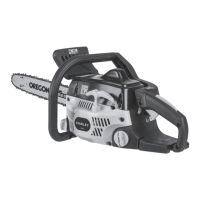SUGGESTED TREE FELLING TECHNIQUES
(PIC. 18)
Note: If unsure about chainsaw operation we suggest doing a
chainsaw course.
• Carefully plan your sawing operation in advance.
• Clear the work area. You need a clear area all around the
tree so you can have secure footing.
• The chain saw operator should keep on the uphill side of the
terrain as the tree likely to roll or slide downhill after it is
felled.
• Study the natural conditions that can cause the tree to fall
in a particular direction. Natural conditions that can cause a
tree to fall in a particular direction include.
• The wind direction and speed.
• The lean of the tree. The lean of a tree might not be apparent
due to uneven or sloping terrain. Use a plumb or level to
determine the direction of tree lean.
• Weight and branches on one side.
• Surrounding trees and obstacles.
Look for decay and rot. If the trunk is rotted, it can snap and fall
toward the operator. Check for broken or dead branches which
can fall on you while cutting. Make sure there is enough room
for the tree to fall. Maintain a distance of 2-1/2 tree lengths from
the nearest person or other objects. Engine noise can drown out
a warning call. Remove dirt, stones, loose bark, nails, staples
and wire from the tree where cuts are to be made. Plan a clear
retreat path to the rear and diagonal to the line of fall.
Felling Large Trees (15cm/6 inches) in diameter or
larger)
The notch method is used to fell large trees. A notch is cut on
the side of the tree in the desired direction of fall. After a felling
cut is made on the opposite side of tree, the tree will tend to fall
into the notch.
Note: If the tree has large buttress roots, remove them before
making the notch. If using saw to remove buttress roots, keep
saw chain from contacting ground to prevent dulling of the
chain.
WARNING
Check for broken or dead branches which can fall while cutting causing serious injury. Do not cut near buildings or electrical
wires if you do not know the direction of tree fall, nor cut at night since you will not be ale to see well, nor during bad weather
such as rain, snow, or strong winds, etc. If the tree makes contact with any utility line, the utility company should be notified
immediately.
OPERATING TIPS
• Check chain tension before first use and after 1 minute of
operation. See CHAIN TENSION on page 14.
• Cut wood only. Do not cut metal, plastics, masonry, non-
wood building materials, etc.
• Stop the saw if the chain strikes a foreign object. Inspect the
saw and repair or replace parts as necessary.
• Keep the chain out of dirt and sand prior to use. Even a small
amount of dirt will quickly dull a chain and thus increase the
possibility of kickback.
• Practice cutting a few small logs using the following
techniques to get the “feel” of using your saw before you
begin a major sawing operation.
• Squeeze the throttle trigger and allow the engine to reach
full speed before cutting.
• Begin cutting with the saw frame against the log.
• Keep the engine at full speed the entire time you are cutting.
• Allow the chain to cut for you. Exert only light downward
pressure. If you force the cut, damage to the bar, chain or
engine can result.
• Release the throttle trigger as soon as the cut is completed,
allowing the engine to idle. If you run the saw at full throttle
without a cutting load, unnecessary wear can occur to the
chain, bar and engine. It is recommended that the engine not
be operated for longer than 30 seconds at full throttle.
• To avoid losing control when cut is complete, do not put
pressure on saw at end of cut.
• Stop the engine before setting the saw down after cutting.
Check Chainsaw Lubrication
1. Start the Chainsaw.
2. Hold the running chainsaw approximately 15cm above a
trunk or the ground (use appropriate base).
3. If the lubrication is sufficient, you will see a light oil trace
because oil will be flung off the saw.
4. If no oil trace is seen, check chain oil reservoir and clean
the chainsaw from debris/dirt.

